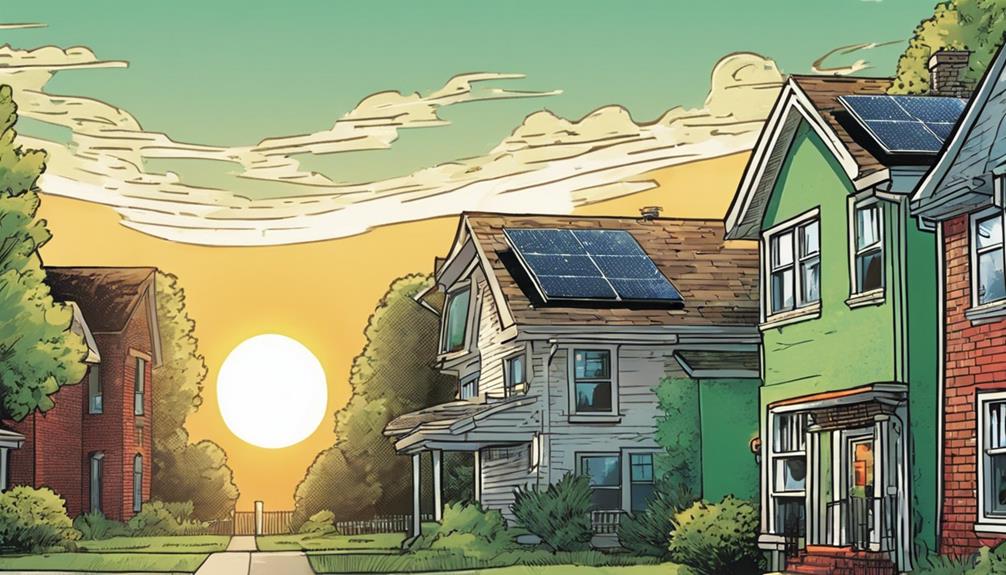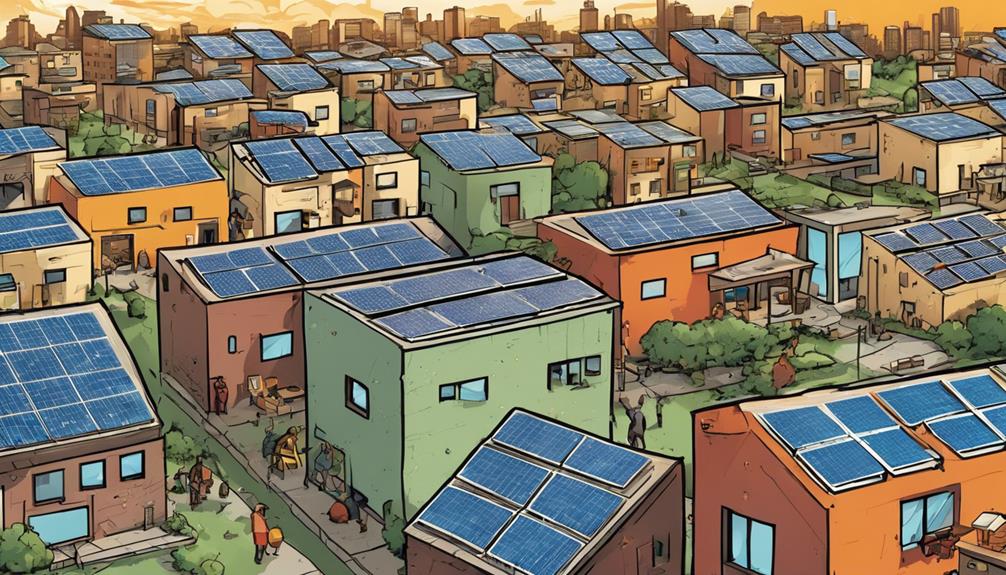You'll find the highest concentration of solar energy usage in California, Arizona, Texas, and Hawaii, where favorable policies, abundant sunlight, and growing demand have propelled these states to the forefront of the US solar energy landscape. These states boast impressive installed solar megawatts, with California leading the way at 26.8%. Cities like Los Angeles, San Diego, and Honolulu are also hotspots for solar adoption, with over 400 MW of installed capacity in LA alone. As you explore further, you'll uncover more about the growth and opportunities driving America's shift towards renewable energy.
Key Takeaways
- California leads in solar energy adoption, producing 26.8% of total U.S. solar energy.
- Arizona, Texas, Hawaii, and Nevada are among the top states for solar energy utilization.
- Cities like Los Angeles, San Diego, Honolulu, Phoenix, and Las Vegas have high installed solar capacity.
- Florida, Massachusetts, New York, and Texas have thriving solar job markets, driving workforce growth.
- Incentives like federal and state tax credits, and rebates, make solar energy more affordable and accessible across the US.
Top States for Solar Energy
As you explore the landscape of solar energy in the US, California stands out as the undisputed leader in solar energy adoption, boasting the most megawatts of solar power installed. The Golden State's commitment to renewable energy goals is evident in its widespread solar installations, generating a substantial amount of electricity through photovoltaic (PV) systems.
You'll also notice Arizona's remarkable progress, with nearly one million solar-powered homes, showcasing significant solar energy utilization. Texas ranks second in installed solar megawatts, highlighting its growing solar energy market. Hawaii and Nevada follow, with impressive percentages of solar power utilization, contributing to their renewable energy goals.
As you investigate further, you'll discover thriving solar job markets in states like Florida, Massachusetts, New York, and Texas, reflecting the growth of the solar industry in these regions. These top states for solar energy are paving the way for a cleaner, more sustainable future, powered by solar energy.
Solar Energy Generation Statistics

You'll find that California dominates the scene, producing a whopping 26.8% of the total U.S. solar energy in July 2024, setting a high bar for other states to follow. As you delve deeper into the solar energy generation statistics, you'll notice a significant 17.8% increase in solar energy generation, indicating a promising growth trend in the sector.
Here's a snapshot of the top and bottom performers in solar energy generation:
| State | Solar Energy Generation (%) |
|---|---|
| California | 26.8 |
| Texas | 13.4 |
| Florida | 5.8 |
| Mississippi | 0.2 |
The data highlights the varying contributions of different states to solar power production, showcasing the regional distribution of solar energy generation. As the Solar Energy Industries continue to evolve, monitoring the capacity is crucial since the inception of utility-scale solar projects. With solar prices decreasing and solar panels cost becoming more affordable, we can expect to see a surge in electricity generated from solar power. The total solar capacity and solar space available for development are vast, and it's up to the best and worst states to capitalize on this opportunity.
Leading Cities in Solar Adoption

Cities across the US are also taking the lead in solar adoption, with Los Angeles, California, spearheading the charge with an impressive over 400 MW of installed solar capacity.
You might be wondering which other cities are following suit. Let's take a look at the top cities in solar adoption:
- San Diego, California: With around 350 MW of solar capacity, San Diego is a close second to Los Angeles in solar adoption.
- Honolulu, Hawaii: Ranking high in solar adoption, Honolulu boasts approximately 265 MW of installed solar capacity.
- Phoenix, Arizona: Phoenix showcases significant solar adoption with over 200 MW of installed solar capacity.
- Las Vegas, Nevada: Las Vegas is a leading city in solar adoption, boasting over 180 MW of installed solar capacity.
As you can see, these cities are paving the way for widespread solar adoption across the US. Their efforts demonstrate the potential for solar energy to power our daily lives. By embracing solar energy, these cities are reducing their carbon footprint and setting an example for others to follow.
Solar Job Markets Across States

As you explore the solar energy landscape in the US, you'll find that California's thriving solar industry has created a hotbed of job opportunities, boasting the highest number of solar jobs in the U.S.
But California isn't the only state where you can find a thriving solar job market. States like Florida, Massachusetts, New York, and Texas also offer significant opportunities in the solar industry.
According to employment data from reputable sources like the Solar Energy Industries Association (SEIA) and the Bureau of Labor Statistics, the solar job market reflects the growth and demand for renewable energy solutions across different states.
The expansion of the solar industry is driving job creation, contributing to the growth of the workforce in the renewable energy sector. As the demand for renewable energy continues to rise, you can expect to see more opportunities emerge in states across the country.
The solar job market is an exciting space, with new positions opening up in installation, maintenance, and more. With the solar industry expanding rapidly, it's an excellent time to explore a career in this growing field.
Incentives for Solar Energy Users

With the rising demand for renewable energy, incentives for solar energy users have become an essential factor in making the switch to solar power a financially viable and environmentally beneficial choice. As you consider installing solar panels, you'll be happy to know that there are several incentives that can help reduce the cost.
Here are some of the incentives you can take advantage of:
- Federal solar tax credit: Claim 26% of your solar system cost in 2021.
- State incentives: Rebates, tax credits, and SRECs can further reduce your solar installation costs.
- Arizona incentives: Get $1,000 per kW rebates and 25% system cost tax credits.
- State-specific incentives: Check your state's incentives to see what's available to you.
These incentives can significantly reduce the upfront cost of installing solar panels, making it a more accessible option for homeowners like you.
With the majority of Americans interested in reducing their home's environmental impact, installing solar panels isn't only a financially viable choice but also an environmentally beneficial one. By taking advantage of these incentives, you can join the growing number of homeowners who are making the switch to solar power.
Frequently Asked Questions
Where Is Solar Energy Most Used in the Us?
You're wondering where solar energy is most used in the US? Well, you'll find it's mainly in California, which leads the pack with the most solar-powered homes and highest installed megawatts, followed closely by Arizona, Texas, and Florida.
In What Locations of the US Is Solar Energy Most Plentiful?
You might think sunlight is everywhere, but you're wrong; it's most abundant in specific locations. You'll find the most solar energy in California, Arizona, Nevada, Texas, and Florida, thanks to their geography and climate.
What Part of the United States Is Best Suited for Solar Energy?
You'll find that the Southwest region, dubbed the 'Sun Belt,' is best suited for solar energy, thanks to its high solar insolation levels, making states like California, Arizona, and Texas ideal for harnessing the sun's power.
How Many Solar Power Plants Are in the Us?
You're wondering how many solar power plants are in the US? As of 2021, you'll find over 2,500 utility-scale solar power plants across the country, with a combined capacity of over 50 gigawatts.
How Does Latitude Affect the Use of Solar Energy in the US?
The latitude’s solar energy dynamics greatly impact the use of solar energy in the US. Areas closer to the equator receive more direct sunlight, making it more effective for solar energy generation. However, even northern states can still effectively utilize solar energy with proper technology and infrastructure.
Conclusion
You've got the whole picture of solar energy in the US, and it's time to soak up the benefits. From the top states harnessing solar power to the leading cities and job markets, the industry is on the rise.
With incentives in place, the future looks bright. It's time to take the reins and join the solar revolution, because when it comes to renewable energy, the US is finally 'seeing the light' and making strides towards a sustainable tomorrow.










